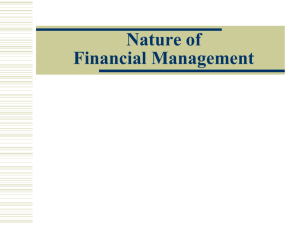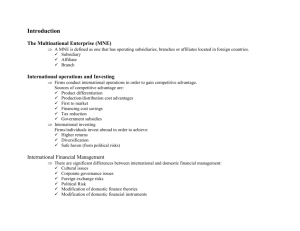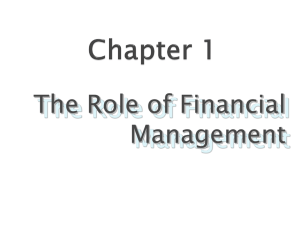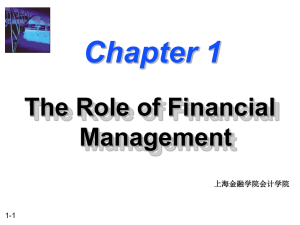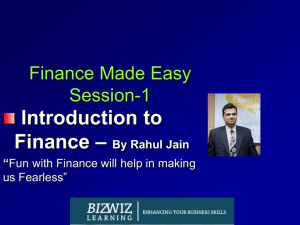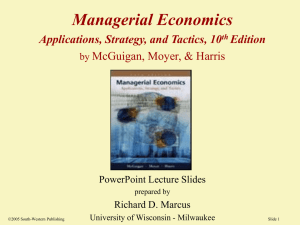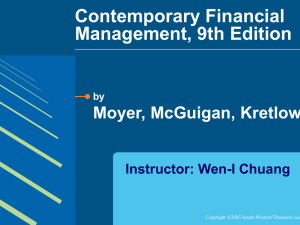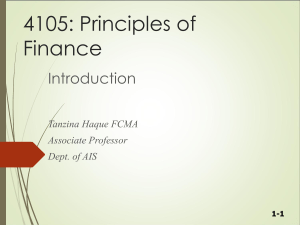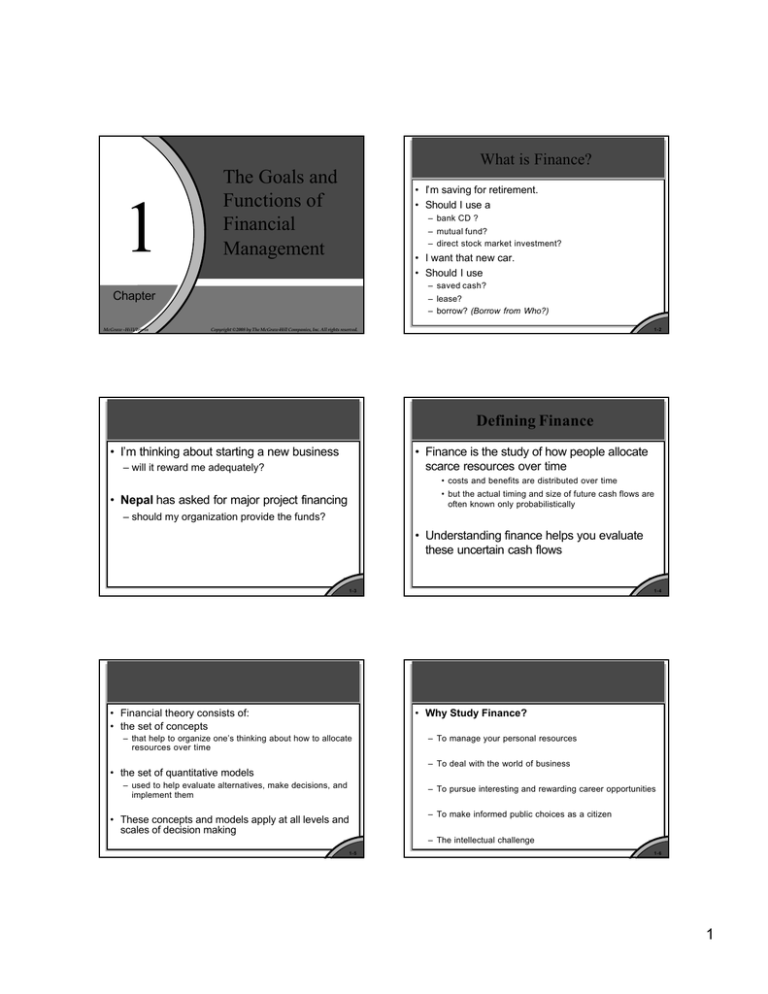
What is Finance?
1
The Goals and
Functions of
Financial
Management
• I’m saving for retirement.
• Should I use a
– bank CD ?
– mutual fund?
– direct stock market investment?
• I want that new car.
• Should I use
– saved cash?
Chapter
McGraw -Hill/Irwin
– lease?
– borrow? (Borrow from Who?)
Copyright ©2008 by The McGraw-Hill Companies, Inc. All rights reserved.
1-2
Defining Finance
• I’m thinking about starting a new business
• Finance is the study of how people allocate
scarce resources over time
– will it reward me adequately?
• costs and benefits are distributed over time
• but the actual timing and size of future cash flows are
often known only probabilistically
• Nepal has asked for major project financing
– should my organization provide the funds?
• Understanding finance helps you evaluate
these uncertain cash flows
1-3
• Financial theory consists of:
• the set of concepts
1-4
• Why Study Finance?
– that help to organize one’s thinking about how to allocate
resources over time
– To manage your personal resources
– To deal with the world of business
• the set of quantitative models
– used to help evaluate alternatives, make decisions, and
implement them
– To pursue interesting and rewarding career opportunities
• These concepts and models apply at all levels and
scales of decision making
– To make informed public choices as a citizen
– The intellectual challenge
1-5
1-6
1
Relationship between Finance,
Economics and Accounting
Financial Management
Ÿ Financial Management or business finance
is concerned with managing an entity’s
money.
Ÿ For example, a company must decide:
-
• Economics provides structure for decision
making in many important areas.
- Provides a broad picture of economic
environment.
• Accounting provides financial data in various
forms.
where to invest its money.
whether or not to replace an old asset.
when to issue new stocks and bonds.
whether or not to pay dividends.
– Income statements, balance sheets, and
statement of cashflows.
• Finance links economic theory with the
numbers of accounting.
1-7
Recent Issues in Finance
1-8
Recent Issues in Finance (cont’d)
• Recent focus has been on:
• The following are significant to financial
managers during decision making:
– Risk-return relationships.
– Maximization of returns for a given level of risk.
– Portfolio management.
– Capital structure theory.
– Effects of inflation and disinflation on financial
forecasting.
– Required rates of return for capital budgeting
decisions.
– Cost of capital.
• New financial products with a focus on
hedging are being widely used.
1-9
Functions of the Financial Manager
1-10
Risk-Return Trade-Off
• Influences operational side (capital versus
labor/ Product A versus Product B)
• Influences financial mix (stocks versus
bonds versus retained earnings)
- Stocks are more profitable but riskier.
- Savings accounts are less profitable and less
risky (or safer)
• Financial manager must choose appropriate
combinations
1-11
1-12
2
Sole Proprietorship
Partnership
• Represents single-person ownership
• Advantages:
• Similar to sole proprietorship except there
are two or more owners.
– Articles of partnership: Specifies ownership
interest, the methods for distributing profits, and
the means of withdrawing from the partnership.
– Limited partnership: One or more partners are
designated as general partners and have
unlimited liability of the debts of the firm; other
partners designated limited partners and are
liable only for their initial contribution.
– Simplicity of decision-making.
– Low organizational and operational costs.
• Drawback
– Unlimited liability to the owner.
– Profits and losses are taxed as though they
belong to the individual owner.
1-13
Corporation
1-14
Corporation (cont’d)
• Corporation
• Disadvantage:
- Articles of incorporation: Specify the rights and
limitations of the entity.
- Its owned by shareholders who enjoy the
privilege of limited liability.
- Has a continual life.
– The potential of double taxation of earnings.
• Subchapter S corporation: Income is taxed as a direct
income to stockholders and thus is taxed only once
as normal income.
- Key feature is the easy divisibility of
ownership interest by issuing shares of
stock.
1-15
1-16
conflict of interest
Goals of Financial Management
•
There may be some conflict of interest between managers and the
owners.
•
Suppose you have to decide between two alternative investments:
Safe ( With lower expected return)
or
Risky ( with higher expected return)?
• Valuation Approach
• Maximizing shareholder wealth (shareholder
wealth maximization)
• Management and stockholder wealth
•
Which one to go for?
- Retention of position of power in long run is by
becoming sensitized to shareholder concerns.
- Sufficient stock option incentives to motivate
achievement of market value maximization.
- Powerful institutional investors are increasing
management more responsive to shareholders.
– Some owners may want safe, but if they want safe, they can pull out their
shares and put in safe assets.
– If risky investment makes to increase the market value of the fi rm, you
should go for the risky one.
•
Would you do it? Conflict of interest may come to play.
1-17
1-18
3
Profit maximization OR Wealth
maximization?
Management rule:
• Maximize the wealth of current shareholders
– Rule depends only upon production technology,
market interest rates, market risk premiums, and
security prices
– Alternative rules stated in terms of “profit
maximization” are fraught with unresolved
issues, and are better avoided
• Case I:
• Suppose initial outlay for two projects is $ 1 Million.
•
Return from
Year 1
Year 2
Profit
•
Project A
$1.05 Million
—
Project B
$ 1.1 Million
$0.05 Million
= $ 50,000
$ 0.1 Million
= $ 100,000
How do you apply profit maximization rule?
1-19
1-20
Profit maximization OR Wealth
maximization?
The agency problem
• CASE II: (Uncertain environment)
•
Return from
Year 1
Profit
Project A
$1.05 Million
$0.05 Million
= $ 50,000
(With certainty)
Project B
$ 1.2 Million OR $ 0.9 Million
with prob. 0.5 each
•
Managers wont work for the owners unless it is in their best interest (From
Harvard Business review)
•
Shareholders rely on CEOs to adopt policies that maximize the value of their
shares.
– Like other human beings, however, CEOs tend to engage in activit ies that increase
their own well being.
$ 0.2 Million OR $0.9 Million
= $ 200,000 OR a loss of $100,000
( With 50% Chance of each)
• What is the meaning of choosing investment that
maximizes profit?
• Why managers have to act for the interest of
shareholders?
•
One of the most critical roles of the board of directors is to create incentives that
make it in the CEO’s best interests. Conceptually this is not a difficult
challenge.
•
Some combination of three basic policies will create the right monetary
incentives for CEOs to maximize the values of their companies:
– Boards can require that CEOs become substantial owners of company stock.
– Salaries, bonuses, and stock options can be structured so as to provide big rewards
for superior performance and big penalties for poor performance.
– The threat of dismissal for poor performance can be made real
1-21
Social Responsibility
1-22
Ethical Behavior
• Adoption of policies that maximize values in
the market attracts capital, provides
employment and offers benefits to the
society.
• Certain cost-increasing activities may have
to be mandatory rather than voluntary
initially, to ensure burden falls equally over
all business firms.
1-23
• Ethical behavior creates invaluable
reputation.
• Insider trading
• Protected against by the Securities and
Exchange Commission (SEC).
1-24
4
Is ethics really relevant?
The Role of Financial Markets
• This is a good question to answer.
– First, although business errors can be forgiven,
ethical errors tend to end careers and terminate
future opportunities. Why? Because unethical
behavior eliminates trust, and without trust
businesses cannot interact.
– Second, the most damaging event a business
can experience is a loss of public’s confidence in
its ethical standards.
• Financial markets are indicators of
maximization of shareholder value and the
ethical or the unethical behavior that may
influence the value of the company.
• Participants in the financial market range
over the public, private and government
institutions.
– Public financial markets
– Corporate financial markets
1-25
Structure and Functions of the Financial
Markets
1-26
Stocks versus Bonds
• Stock = ownership or equity
• Money markets
- Securities in this market include commercial
paper sold by corporations to finance their daily
operations or certificates of deposit with
maturities of less than 12 months sold by banks.
• Capital markets
- Stockholders own the company
• Bond = debt or IOU
- Bondholders are owed $ by company
- Long-term markets
- Securities include common stock, preferred
stock and corporate and government bonds.
1-27
1-28
Return Maximization and Risk
Minimization
Allocation of Capital
• Primary market
– When a corporation uses the financial markets
to raise new funds, the sale of securities is made
by way of a new issue.
• Secondary market
– When the securities are sold to the public
(institutions and individuals).
– Financial managers are given a feedback about
their firms ’ performance.
1-29
• Investors can choose risk level that meets
their objective and maximizes return for that
given level of risk.
• Companies that are rewarded with highpriced securities can raise new funds in the
money and capital markets at a lower cost
compared to competitors.
• Firms pay a penalty for failing to perform
competitively.
1-30
5
Internationalization of Financial Markets
Restructuring
• Restructuring can result in:
• Allocation of capital and the search for low
cost sources of financing on the rise in
global market.
• The impact of international affairs and
technology has resulted in the need for
future financial managers to understand
– Changes in the capital structure (liabilities and
equity on the balance sheet).
– Selling of low -profit-margin divisions with the
proceeds of the sale reinvested in better
investment opportunities.
– Removal or large reductions in the of current
management team.
- International capital flows.
- Computerized electronic funds transfer systems.
- Foreign currency hedging strategies.
• It has resulted in acquisitions and mergers.
1-31
1-32
Technological Impact on Capital Market
• Consolidation among major stock markets
and mergers of brokerage firms with
domestic and international partners.
• Electronic markets have gained popularity as
against traditional organized exchanges and
NASDAQ.
• Resulted in the merger of NYSE with
Archipelago and NASDAQ bought out
Insinet from Reuters.
1-33
6


